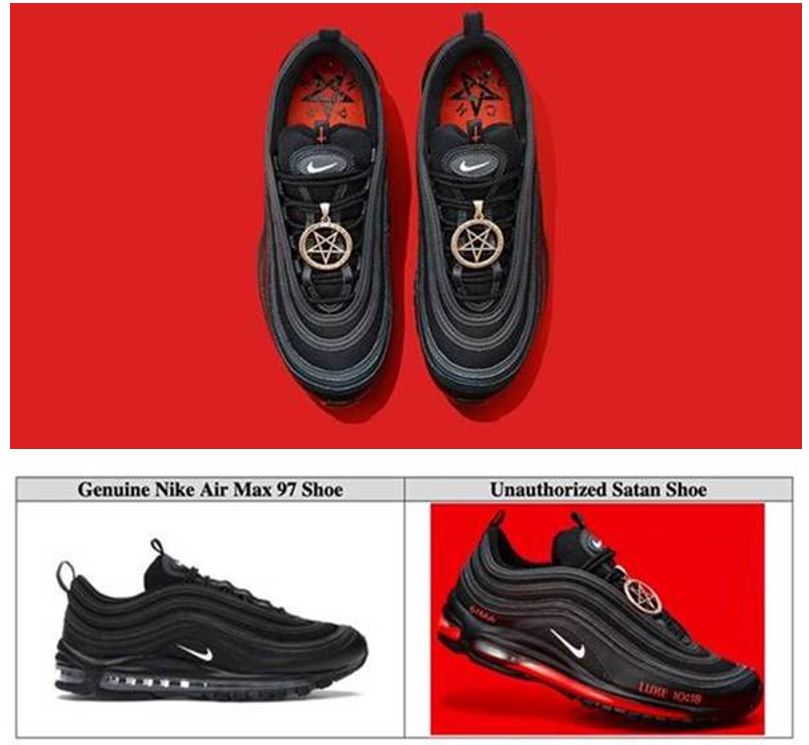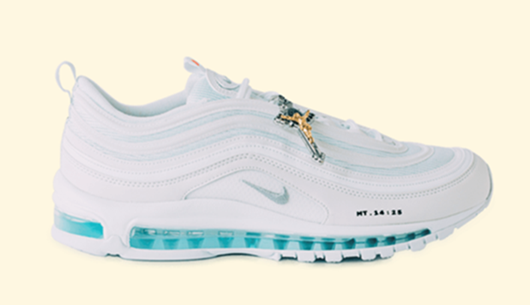28/04/2021
On 26th March this year, Brooklyn, New York, based art collective MSCHF Product Studio, Inc. announced the launch of a pair of ‘Satan’ themed training shoes that were an instant sensation. The shoes were a limited edition collaboration with Grammy award winning rapper and media personality Lil Nas X and used the black on black version of Nike’s Air Max 97 as their basis. Nike however was not a part of the collaboration and had no input into either the design or manufacture of the shoe.
Despite retailing at $1,018 (a reference to Luke 10:18, a Bible verse about Satan’s fall from heaven), all 666 pairs of the shoes sold out less than a minute after launch. The shoes were also part of the publicity for Lil Nas X’s ‘Montero’ song and video, which also used some Satanic imagery. While the song was largely praised for addressing a number of important cultural and social issues, the shoes were given a more mixed reception with a number of (primarily conservative) news outlets voicing disapproval. The shoes also drew condemnation from, among others, South Dakota’s Republican governor, Kristi Noem, and were even the subject of a church sermon which has since gone viral.
Nike reacted by issuing a statement distancing itself from the shoes and followed this with a lawsuit for trademark infringement, false designation of origin, trademark dilution, and unfair competition. As part of its claim for trade mark infringement, Nike alleged that the shoes made consumers believe that “Nike is endorsing Satanism”.
Nike were subsequently granted a restraining order against MSCHF preventing them from fulfilling any orders where the shoes had not already been dispatched.
The parties settled the matter shortly after the restraining order was issued, MSCHF agreeing to refund all parties who returned the shoes in order to take them out of circulation. It does not appear that Nike sought damages or costs.
In all, the entire matter lasted less than a month and was settled in a way that appeared both parties were happy with. Nevertheless, despite its brevity the matter still involved a number of interesting issues and given the high profile of the parties, much online speculation.
The ‘Satan’ Shoes
They featured a bronze pentagram on the laces and an inverted cross, while on the sides of the shoes is a reference to the Bible passage Luke 10:18. The soles of the shoes were also filled with “60cc of ink and 1 drop of human blood”. Detail from Jan van Eyck’s Last Judgement is also included in the packaging.

Notably from a trade mark law perspective, the famous Nike Swoosh logo still appeared on the Satan shoes in exactly the same position as on the Air Max 97 and was not modified or altered.
Freedom Of Speech
An interesting argument put forward by MSCHF in its defence was that the shoes were protected by their First Amendment right to free speech—namely, to comment on consumer culture and to criticise religious norms that demonise homosexuals. This kind of ‘free speech’ defence can be successful where the trade mark in question is used in a context that clearly conveys a joke or social commentary, such that consumers are unlikely to mistakenly believe that the trade mark owner condoned the use. Lil Nas X was also dismayed at the restraining order Nike were granted, commentating that, “I feel like it’s (expletive) up they have so much power they can get shoes cancelled – freedom of expression gone out the window.”
Although it is certainly an interesting argument, it was unlikely to be successful. Nike argued that MSCHF’s mass-produced shoes are not entitled to the same protection as a single work in a museum or in a satirical magazine, that MSCHF’s “work of art” demonstrates no artistic relevance to Nike’s trade mark, and that any religious commentary is divorced from Nike’s company, brand, and the shoes that MSCHF is using as the vehicle for its message. Moreover, even if there were some protectable art at play, Nike asserted that MSCHF incorporated more of Nike’s trade dress than necessary to accomplish its message, including, most prominently, Nike’s famous Swoosh mark.
Generally speaking, these sorts of arguments are likely to succeed or fail on the question of whether the consumer was likely to believe that the trade mark owner was in some way responsible for the product, even if it was only by way of its approval. In the circumstances of this case, Nike would likely have been able to argue that consumers would have thought that the shoes were a result of a collaboration. MSCHF argued that the ‘sneakerhead’ consumer was particularly knowledgeable and therefore was unlikely to be confused, taking into account the very high price point of the Satan shoes. While this was a reasonable argument, Nike was able to point to instances of actual online confusion. This was almost certainly the reason why Nike were granted the restraining order.
The ‘First Sale’ doctrine [Exhaustion of Nike’s Trade Mark Rights]
MSCHF also argued that as the Air Max 97 shoes that were modified to make the Satan shoes had already been placed on the market by Nike, it could not object to further sales of the same product.
Again, at first instance, this also seems like a good argument. However, the first sale doctrine does not apply where the product has been “materially altered” prior to resale and accordingly is not “genuine.” Nike argued that the Satan shoes had been “customised in such a manner that they constitute new, unauthorized products” and therefore that they were not genuine and that the First Sale doctrine did not apply.
Nike’s arguments on this point may come across as slightly contradictory – i.e. on the one hand arguing that consumers would be confused as to the origin of the shoes and think that Nike was involved in some way, but on the other hand arguing that the shoes had been modified to such an extent that they would no longer be perceived as genuine – but the strongest part of its argument was that material alterations to the original Air Max 97 such as the injection of human blood and red ink into the midsole may pose safety risks for purchasers, and because it wasn’t involved, Nike had no opportunity to inspect the shoes for quality. It is likely that this argument would have been persuasive, together with the fact that, in general, the first sale doctrine is not intended to sanction this kind of mass alteration of another’s product without permission.
Overall, it seems likely that Nike would have been successful if the matter was contested. Which likely prompted the settlement and the prompt resolution of the matter.
Aside from the legal issues, the public controversy surrounding the Satan shoe and its aftermath – including the parties’ settlement – seems the more interesting angle.
As indicated MSCHF’s attorneys, MSCHF’s controversial statement was intentional, and Nike’s lawsuit effectively amplified MSCHF’s artistic message. However, outcry cuts both ways and is probably also a large part of the reason MSCHF agreed to the voluntary recall. That’s because the outcry evidenced actual confusion, which would likely have been the death knell to MSCHF’s First Amendment defence.
For Nike’s part, given the public protest, its aggressive response made sense. But so, too, did its ultimate decision to settle for a voluntary rather than a mandatory recall. Even though Nike likely had the upper hand when it comes to the law, forcing a mandatory recall was unlikely to reflect well on Nike or increase its popularity among ‘sneakerheads’ who paid over $1,000 to purchase the collectible Satan shoes (which are now all the more valuable because of the ban on additional sales).
It also raises interesting questions in relation to brand promotion. Nike is no stranger to limited edition collaborations and is clearly aware of the kudos these bring to its brand. It has also not shied away from ‘controversy’ and the ire of the conservative establishment in the past, as its advertising campaign prominently featuring Colin Kaepernick during the Trump administration has shown. However, the association with Satanism appears to have been a bridge too far for the company and the law suit may have been as much about being seen to take action, as the action itself. It is open to question whether Nike would have acted without the resulting furore and it is worth noting that when MSCHF customised a white on white version of the Air Max 97 for a ‘Jesus’ shoe in 2019 (complete with holy water in the sole!), Nike did not complain.

Overall, the case is a reminder that not all publicity is necessarily good publicity and public opinion is often a powerful driver behind subsequent legal action and even ventures that may provide cutting edge publicity opportunities will likely be shut down if the brand is not being used in the ‘correct’ way.
This article is for general information only. Its content is not a statement of the law on any subject and does not constitute advice. Please contact Reddie & Grose LLP for advice before taking any action in reliance on it


